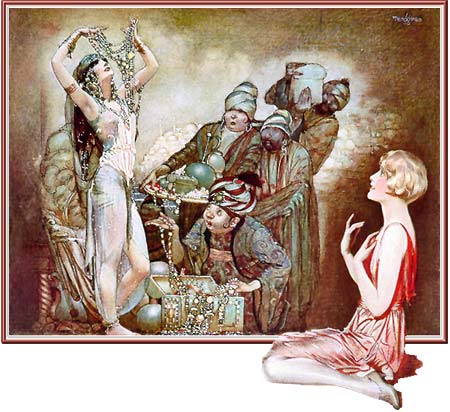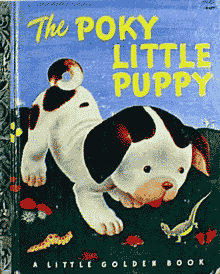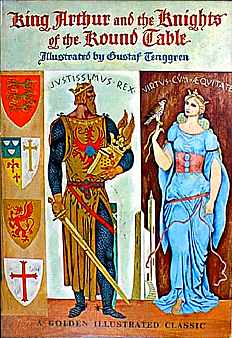


 |
He's in #s 2, 3 & 12 and half of issue #6 is devoted to pre-1923 work! |
 Gustaf
Tenggren was born November 3, 1896 in Vastergotland, Sweden. His
early schooling and artistic influences were solidly grounded
in Scandinavian techniques, motifs and myths. At the age of 20
he succeeded John
Bauer as the illustrator for Bland Tomtar och Troll (Among Elves and Trolls),
a famous Swedish Christmas annual for children. He illustrated
the fairy tales by Swedish artists in the annual from 1917 through
1926 - the last six years from America.
Gustaf
Tenggren was born November 3, 1896 in Vastergotland, Sweden. His
early schooling and artistic influences were solidly grounded
in Scandinavian techniques, motifs and myths. At the age of 20
he succeeded John
Bauer as the illustrator for Bland Tomtar och Troll (Among Elves and Trolls),
a famous Swedish Christmas annual for children. He illustrated
the fairy tales by Swedish artists in the annual from 1917 through
1926 - the last six years from America.
During this period he also illustrated an Andersen's Fairy Tales for a publisher in Denmark. In 1920 he immigrated to the U.S., to Cleveland and then in 1922 to New York. By 1923 he was hard at work breaking into the American children's book market - the heyday of the grand illustrated books of Rackham and Nielsen (a kindred artistic spirit) having passed before his time.
In 1923 in America, his work appeared in Wonder Book and
Tanglewood Tales, D'Aulnoy's Fairy Tales, A Boy
of the Lost Crusade, The Christ Story for Boys and Girls,
and Heidi, with a Grimm's Marchenschatz being published
in Germany.
 1924
through 1928 saw a steady stream of books: The Good Dog Book,
The Red Fairy Book, Peggy's Playhouses, A Dog
of Flanders, a "1925 Fairy Tale Calendar"
for Beck Engraving Co, a dust jacket for a novel Quest,
Small Fry and the Winged Horse, (see the Viking illustration
at left), Juan and Juanita, and Dickey Byrd. His
illustrations appeared in Good Housekeeping in a column
"by ELAINE, Entertainment Editor" and in advertisements
for the International Silver Co, Heisey's Glassware, Elgin Watches
(the first illustration above - from 1926), and he even provided
illustrations for some few stories.
1924
through 1928 saw a steady stream of books: The Good Dog Book,
The Red Fairy Book, Peggy's Playhouses, A Dog
of Flanders, a "1925 Fairy Tale Calendar"
for Beck Engraving Co, a dust jacket for a novel Quest,
Small Fry and the Winged Horse, (see the Viking illustration
at left), Juan and Juanita, and Dickey Byrd. His
illustrations appeared in Good Housekeeping in a column
"by ELAINE, Entertainment Editor" and in advertisements
for the International Silver Co, Heisey's Glassware, Elgin Watches
(the first illustration above - from 1926), and he even provided
illustrations for some few stories.
| 1932 was a banner year for Tenggren. He illustrated one of my favorites among his books, Sven the Wise and Svea the Kind, which only had two color plates but they were gorgeous (as you can tell from the sample to the right). Both this title and The Ring of the Niblung featured his pen work, which we also like. Here's why. |  |
|
 |
His most atypical work to date occurred in a non-fiction children's
book entitled How They Carried the Goods, also in 1932,
in which he was called upon to paint pictures of many things,
including an airplane. A few other books follow until 1936, one unusual
example being 1933's oddly named Seldom and the Golden Cheese,
with more pen and ink work. About this time he also painted the
dust wrapper for a famous Pearl S. Buck novel, The Good Earth.

|
|
His career was about to take a dramatic turn and his style
was never to be the same. In 1936, Tenggren went to work for Walt
Disney...
 You
can see his work throughout Snow White and in many
of the richly detailed urban backgrounds of Pinocchio,
for which he obviously drew upon his Scandinavian heritage and experience. His Arthur Rackham-esque trees featured prominently
in the Snow White forest scenes as can be seen at left - taken
from the 1938 Grosset & Dunlap Snow White and the Seven
Dwarfs.
You
can see his work throughout Snow White and in many
of the richly detailed urban backgrounds of Pinocchio,
for which he obviously drew upon his Scandinavian heritage and experience. His Arthur Rackham-esque trees featured prominently
in the Snow White forest scenes as can be seen at left - taken
from the 1938 Grosset & Dunlap Snow White and the Seven
Dwarfs.
In his wonderful Before the Animation Begins - The Art and Lives of Disney Inspirational Sketch Artists, John Canemaker devotes ten pages to Tenggren and his art. It's a must-have book in our opinion.
As significant and as powerful as his Disney work turned out to be, he emerged from the experience in 1939 with a very different approach to art. It was still rich and colorful, but the inspirations of Bauer and Rackham and Nielsen were jettisoned for, well, you decide... Not
four years after his elegant contributions to Disney, Tenggren
explodes back upon the book market with ... The Poky Little
Puppy, in a new, simplified, flatter style that fails to satisfy
me as did his romantic earlier work.
Not
four years after his elegant contributions to Disney, Tenggren
explodes back upon the book market with ... The Poky Little
Puppy, in a new, simplified, flatter style that fails to satisfy
me as did his romantic earlier work.
 His
output, though, increased dramatically, as did the marketability
of his name. The Forties and Fifties saw an endless stream of
Tenggren books: The Tenggren Tell-It-Again Book, The
Tenggren Story Book, Tenggren's Cowboys and Indians,
Tenggren's Thumbelina, Tenggren's Jack and
the Beanstalk, Tenggren's Mother Goose, etc.,
as well as a mob of Little Golden Books from The Biggest Bear
to Little Black Sambo.
His
output, though, increased dramatically, as did the marketability
of his name. The Forties and Fifties saw an endless stream of
Tenggren books: The Tenggren Tell-It-Again Book, The
Tenggren Story Book, Tenggren's Cowboys and Indians,
Tenggren's Thumbelina, Tenggren's Jack and
the Beanstalk, Tenggren's Mother Goose, etc.,
as well as a mob of Little Golden Books from The Biggest Bear
to Little Black Sambo.
King Arthur, at left, is his last book - from 1961. He died in 1970 leaving behind a half century of art that continues to amaze and entertain to this day.
 To find out more about Gustaf Tenggren, see:
To find out more about Gustaf Tenggren, see:| Before the Animation Begins | John Canemaker, 1996, Hyperion |
| From Swedish Fairy Tales to American Fantasy | Mary T. Swanson, 1986, University of Minnesota |
| The Vadeboncoeur Collection of Knowledge | Jim Vadeboncoeur, Jr. 1997 |
| The Vadeboncoeur Collection of ImageS 2, 3, 6, 12 | Jim Vadeboncoeur, Jr. 2001-03, 2010 JVJ Publishing |
|
Illustrations copyright by their respective owners. This page written, designed & © 1997 by Jim Vadeboncoeur, Jr. Updated 1999, 2011. |
